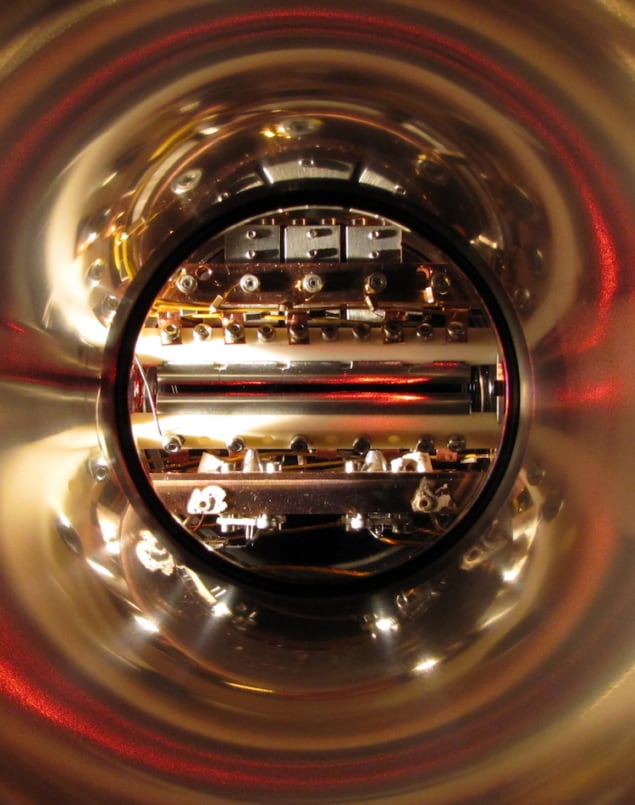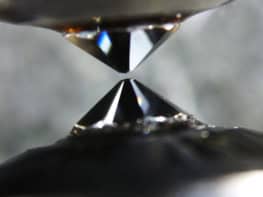
The most precise measurement to date of the proton-electron mass ratio suggests that the proton may be lighter than previously thought. The result, from researchers in the Netherlands and France, provides a crucial independent cross-check with previous measurements of the ratio, which yielded inconsistent values.
The proton-electron mass ratio is an important quantity in physics and a benchmark for molecular theory. It can be determined by measuring the rotations and vibrations of ordinary molecular hydrogen ions (H2+) and comparing them to similar ro-vibrational measurements in their deuterated cousins (HD+). Both entities are the very simplest bound systems that can be termed “molecules”, and as such they are ideal for probing models of fundamental physics. Indeed, when researchers first performed measurements of ro-vibrational transitions in HD+ 40 years ago, they suggested that the results could be used to test the theory of quantum electrodynamics (QED) in molecules.
Most precise determination of the proton-electron mass ratio
Recent measurements of the relative atomic masses of light atomic nuclei – including deuterons and helions (helium-3 nuclei) as well as protons – have, however, uncovered values that differ from earlier results by several standard deviations. For example, a proton-mass measurement made in 2017 using a traditional method, Penning-trap mass spectrometry, determined the mass with a precision of 32 parts per trillion (ppt). While this precision of this measurement was three times higher than that of the previously accepted value (termed CODATA-2014), the actual value measured was nearly 300 ppt smaller.
“This value was taken along with the earlier values to compute the 2018 CODATA value of the proton mass, but all uncertainty margins had to be stretched by a factor of 1.7 to cover the difference,” explains study team leader Jeroen Koelemeij of VU University in Amsterdam. “This currently limits the precision of the ‘official’ proton-electron mass ratio to 60 ppt – and affects theoretical calculations of HD+ at a similar level.”
In their new work, Koelemeij and colleagues used a different technique, Doppler-free two-photon laser spectroscopy of trapped HD+ ions, to measure a proton-electron mass ratio of 1,836.152 673 406(38), where the brackets contain the statistical uncertainty. At 21 ppt precision, this measurement is the most precise determination of the proton-electron mass ratio to date – a record shared with a very recent value obtained from rotations of HD+ in a concurrent experiment in Düsseldorf, Germany.
Getting rid of the Doppler effect
In measurements like these, Koelemeij explains that the Doppler effect – the apparent detuning of the laser frequency from resonance with the HD+ ion, depending on the ion’s velocity – is a nuisance. Even at the very low temperatures (10 mK above absolute zero) that prevail in their experimental trap, the molecules in the trap can still move around. To eliminate the Doppler effect entirely, the ions would ideally need be brought to a complete standstill – an experimental impossibility.
“Fortunately, quantum mechanics is forgiving,” Koelemeij says. “If we want a laser to ‘see’ a particle at rest, we just need to ensure that it doesn’t move around by more than the wavelength of the laser light” – a condition known as the Lamb-Dicke limit.
Koelemeij and colleagues met this condition in a roundabout way by shining two lasers on the molecule from opposite directions. When the wavelengths of these counter-propagating laser beams are tuned to the right values, the molecule will absorb a photon from each beam and, in effect, add the energy from both photons to its own vibrational energy. The resulting “two-photon” transition between the molecule’s energy levels has an apparent wavelength equal to the difference between the two laser wavelengths. “Since both lasers have nearly the same wavelengths, the apparent wavelength becomes very large – larger than the volume in which the HD+ ions are confined,” explains Koelemeij. “According to quantum mechanics, the ions appear to be standing still: no Doppler effect.”
With the Doppler effect removed, the true purity of the vibrations becomes visible, Koelemeij tells Physics World. Indeed, the vibrations of the molecules under these circumstances is nearly as pure as the oscillations in the best atomic clocks – meaning that they can be measured with high precision.
Another advantage of the technique is that by using two photons, the researchers can select molecular vibrations in a way that is relatively insensitive to magnetic fields, which helps improve the precision of the measurement.
QED theory works for molecules
The new work, which is detailed in Science, confirms that QED, which is very successful at describing single particles and atoms, also works for more complex matter such as simple molecules – something that Koelemeij says was previously unclear. “While there have been comparisons (and agreement) between QED theory of molecules (notably the HD+ ion) and experiment, the experiments were never more precise than theory,” he explains. “This means that the finest details of the theory calculation could not be tested.”

Correlations between protons and neutrons may explain 35-year-old nuclear mystery
The new result, he says, has turned the situation on its head. For the first time, experimental measurements of these molecular vibrations are significantly more precise than values generated from theory – meaning that theoretical predictions can now be tested to the fullest extent. What’s more, predictions from theory can be used as a tool to translate the measured vibrations into a new value of the proton-electron mass ratio – as predicted more than four decades ago.
“Intriguingly, the proton-electron mass ratio we have measured is in fact compatible with the recent measurements of the proton mass, which were unexpectedly smaller than previous reference values,” adds Koelemeij. “This means that the proton indeed seems to be lighter than we thought.”
The very precise measurements in HD+ could also help solve several important and hotly debated mysteries in physics, including the puzzle of why the radius of the proton appears to be smaller than expected. Knowing the mass of the proton (and the anti-proton) to high precision could also help researchers understand why there is much more matter than antimatter in the universe, even though equal quantities of each were thought to have been created in the Big Bang.



